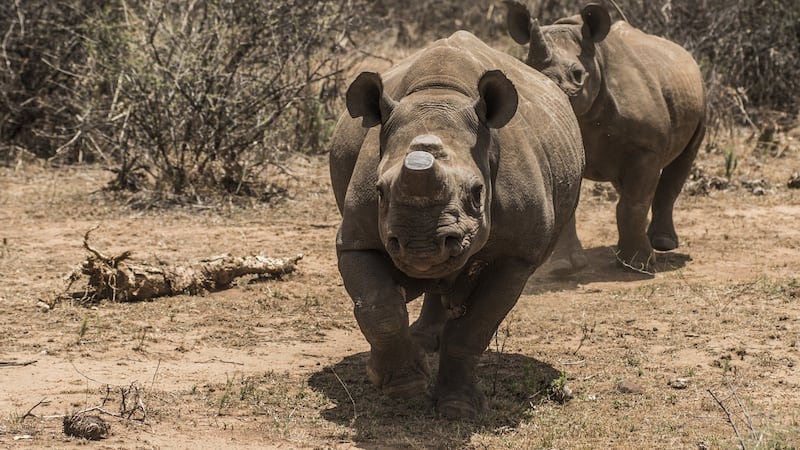in Johannesburg The US government is stepping up efforts in Johannesburg to combat illegal wildlife poaching, an expanding criminal enterprise in South Africa that has driven several animal species toward extinction and fueled the growth of international gangs.
But the effort is coming as South Africa wrestles with its own strategy, which could diverge significantly from Washington's. Just last month, a South African court lifted a ban on domestic trade in rhinoceros horns, reigniting a debate between those who claim that a legal trade within South Africa's borders could help stem the poaching crisis and those who say it would only worsen it.
Tipping the scale, the Obama administration is pouring millions of dollars into training and intelligence gathering to help counter losses among endangered species like the African rhino. South Africa in home to 80 per cent of the world’s rhino population.

The US sees national security implications to poaching since it is generally carried out by gangs that also traffic in guns, people and drugs. “The bottom line is the impact of wildlife trafficking isn’t just contained to Africa,” says US senator Chris Coons, who has introduced legislation to require the Obama administration to develop a country-by-country strategy on poaching. “The impacts of this rapidly growing crisis are spreading around the world, now even threatening our national security.”
Trafficking in wildlife has decimated elephant and rhino populations in Africa. In the first eight months of this year, poachers had killed 749 rhinos in South Africa, up from 716 over the same period in 2014, according to the latest figures from the South African government.
Headaches and hangovers
In many Asian countries, especially
Vietnam
and
China
, rhino horns are believed to cure ailments such as headaches and hangovers, and a single rhino horn can fetch up to $60,000 (€55,000). The horns are also made into libation cups and are considered a symbol of wealth among the emerging middle class in Asian countries. Illegal wildlife trafficking is estimated to be a roughly $20 billion-a-year enterprise globally.
But the trade has moved beyond Asia. The US has grown into the second-largest market for illegal wildlife products and is a major conduit of contraband flowing across the Pacific. One of the many groups being funded by the US to help combat the illegal wildlife trade in South Africa is the Endangered Wildlife Trust, an environmental group that works to protect endangered animal and plant species. Based in an industrial park just outside Johannesburg, the group is one of three non-governmental organisations here that recently received a combined $1.8 million in grants from the US state department to train law enforcement and government officials to use surveillance equipment and to identify and protect endangered plant species.
Lack
of skills Adam Pires, who runs training programs for the wildlife trust, said that many law enforcement officials often lack the skills to properly investigate poaching. “Most of these guys are used to covering murders and street crimes,” Pires
says. “They don’t know anything about collecting evidence for environmental crimes or preserving a poaching crime scene.”
The US department of justice has received $100,000 from the state department to provide training for prosecutors and judges from six southern African countries to combat illegal animal and plant sales. The training, which was held in Zambia, focused on criminal investigation procedures such as establishing a chain of custody, tracing assets and prosecuting environmental cases, says John C Cruden, the assistant attorney general for the justice department's environment and natural resources division.
“We’re ratcheting up our efforts in southern Africa since this is where so much of the illegal rhino horns and other materials come from,” Cruden says. The wildlife trust has provided anti-poaching training to more than 450 police and intelligence officials. The training, Pires says, has contributed to an increase in the number of people arrested for poaching. Arrests in Kruger National Park, a major area of operations for poachers in South Africa, totalled 138 as of August 2015 compared with 81 arrests over the same period last year, according to government data.
US funding has also gone into helping provincial governments buy equipment such as night-vision goggles, said Moses Rannditsheni, a spokesman for the South African department of environmental affairs. The South African government has requested boots, tents and other survival gear discarded by the defence department and the coast guard through the Excess Defense Articles program, which offers equipment free or at a discount to foreign governments, Rannditsheni says.
Neighbouring countries
Anti-poaching efforts in South Africa and neighbouring countries are part of a larger US effort to stem the booming illegal trade in wildlife. The recently completed Trans-Pacific Partnership trade agreement includes deals with several Asian countries to require them to enforce laws and regulations to protect wildlife covered under an international treaty that protects endangered flora and fauna.
According to research by the Terrorism, Transnational Crime and Corruption Center at George Mason University, the illegal trade is being driven by international criminal gangs, most of which are non-African. The centre received a grant of nearly $400,000 from the state department to identify syndicate leaders, trade routes and financiers in the South African wildlife trade.
Louise Shelley, the director of the centre, says the gangs are led by Pakistani and other Asian poachers who use African middlemen to hunt and transport the animals. People involved in the illegal wildlife trade in South Africa also deal in drugs and cigarettes.
Shelley says the centre’s efforts to fully grasp the size and composition of illegal poaching have been hampered by a lack of co-operation and intelligence sharing from the South African government. “They have not been willing to share any information with us,” she says. The South African police service, one of the law enforcement agencies leading the government’s anti-poaching efforts, did not respond to requests for comment.
– (New York Times service)











